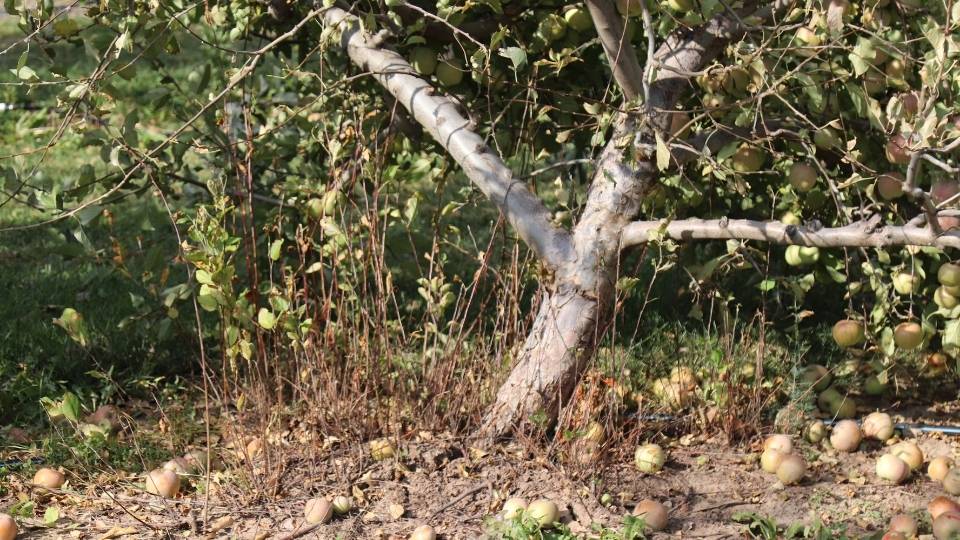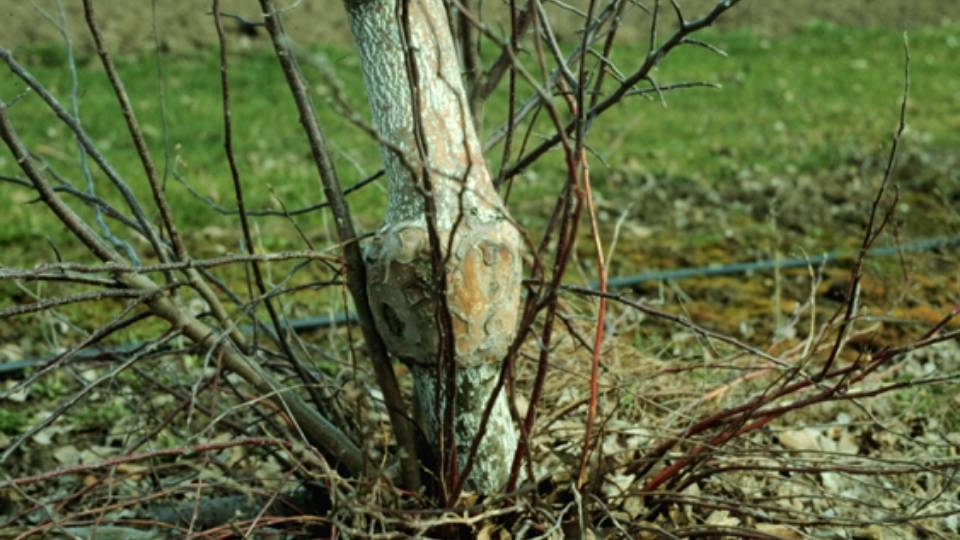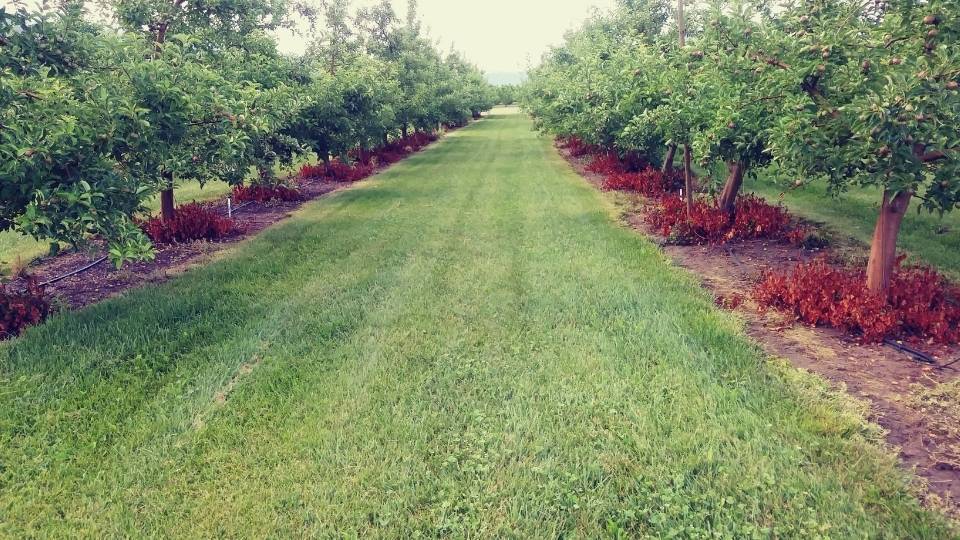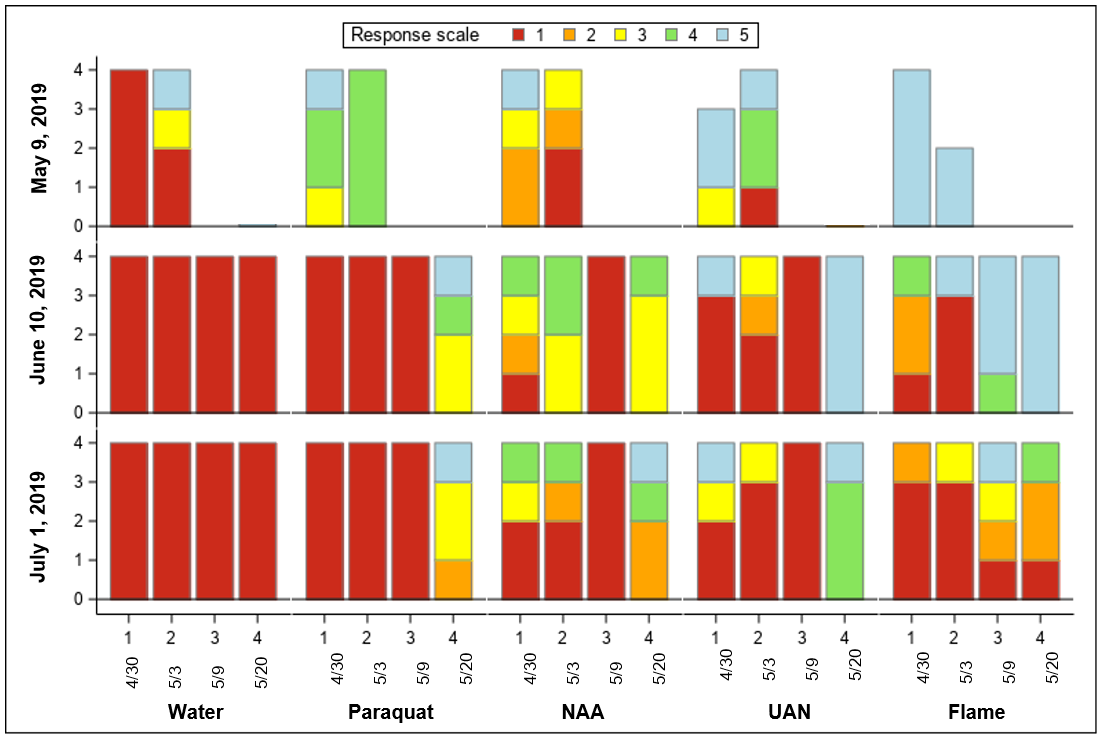Managing Suckers Around Fruit Trees

Many types of fruit trees produce suckers around the base of the tree. Crown suckers arise in the area immediately surrounding the tree trunk. Root suckers can arise from roots further away from the trunk. Suckers around trees are unsightly and they can harbor insect pests like wooly apple aphid and can be points of entry for diseases like fire blight. If suckers are profuse they interfere with in-row weed management and can absorb systemic herbicides such as glyphosate. Some rootstocks used for fruit trees such as M.7 for apples and Mazzard for cherries are genetically predisposed to produce suckers.M.9 clone RN-29 is more inclined to sucker than other M.9 clones. In some cases, sucker growth is a symptom of partial incompatibility between the rootstock and scion.Suckers can also result from injury to the crown such as extreme cold or mechanical injury. Whatever the cause, managing suckers takes time and expense.
Sucker management falls into two general categories: mechanical and chemical. Each approach has merit depending on the orchard situation
Mechanical Control

When onlya few suckers are present, they are often removed during dormant pruning. In severe cases, sickle bar style mowers or gas-powered hedge shears have been used to remove suckers. However, in some situations when suckers are mechanically removed multiple new shoots can arise from cutting a single sucker, making the problem worse. Mechanical control is also expensive and labor intensiveand may have to be done more than once per year. Related to mechanical control is control by heat. In a USU trial, burning suckers with a propane torch provided good control that lasted several weeks. This may be an effective approach for a few suckers here and there. Treating an entire block with a torch would require very slow drive speeds and would consume a substantial amount of propane. Care would also need to be taken to not damage irrigation tubing.
Chemical Control
Chemical control of suckerscan be effective andis less labor intensive than mechanical control. Many acres can be treated in a day by a single operator. Chemical controls for suckers can be grouped into three categories: Plant growth regulators, herbicides, and desiccants.
Plant Growth Regulators
Commercial fruit growers have long used a synthetic auxin,Naphthalene Acetic Acid (NAA),to reduce the growth of suckers.This is the same plant growth regulator (PGR) that is used to thin fruit, but the timing, and concentration are very different. Because NAA will cause a thinning response, application must be delayed until a month after petal fall. This allows time forthe fruit to set and become less sensitive to NAA. Nevertheless, application should be made at a low pressure (10-20 psi) using nozzles that produce large droplets to reduce drift. A specific formulation of NAA (Tre-Hold A-112™)is registered for this use. For apples an 0.5% to 1% solution of NAA should reduce the growth of root suckers.
Herbicides
Some specific contact herbicides are registered for sucker managementfor fruit trees.While these are registered for sucker suppression or control, they are still herbicides and can damage trees, especially young treeswhere the bark is green and not yet corky. Therefore, care must be taken during application to not treattree trunks.Young trees should have trunk wraps installed before application ofherbicide products. Contact herbicides have the added advantage of providing some control for weeds that may have emerged since spring herbicide applications.
General principles for application of herbicides for sucker management include spraying only when winds are calm, using low pressure, and large droplet size. Low drift nozzles are preferred. The use of off-center nozzles may lead to overspray on trunks. For these contact herbicides, good coverage of the foliage is essential. Thus, sufficient water must be sprayed to thoroughly wet the leaves. Control is best when the suckers are still youngand succulent, and not woody.
Paraquat(Gramoxone™) is a caustic, non-systemic, post-emergent herbicide that burns green vegetation. Paraquat is rapidly absorbed by green plant tissues and reacts with photosynthesis to produce superoxides that kill the plant cells.Paraquat is highly toxicto humansand is a restricted use pesticide that can only be mixed and applied by certified pesticide applicators. It provides good burn down of suckers at the higher rates.
Glufosinate (Rely280™, Cheetah™) is another contact herbicide that is registered for sucker management.It is the slowest acting of the herbicide products included in this fact sheet. It can take 20-25days to reach the level of control provided by the other herbicides in 10-14 days.
Carfentrazone-ethyl (Aim EC) is registered for sucker control in fruit trees. Aim must be applied using a hooded sprayer to minimize the opportunity for drift. Also, it must be mixed with an appropriate rate of a nonionic surfactant or crop oil concentrate. While Aim is effective at controlling suckers while they are green and non-woody, the opportunity for injury from drift makes this a less desirable choice.
Pyraflufen-ethyl (Venue) is a contact herbicide for post-emergent control of a range of broadleaf weeds. It also has a supplemental label for control of suckers in fruit trees. It is fast acting and effective at the 4 fl. oz/a rate. Cherry suckers are more susceptibleto Venuethan apple.
Table 1. Use patterns for herbicides registered for sucker control in tree fruits.Check product labels for specific use information
| Generic name (Trade name) |
Rate/acre | Applications/yr | REI (hours) |
|---|---|---|---|
| Paraquat (Gramoxone) |
2.5 to 4 pt/a | 3 | 12 |
| Glufosinate Rely, (Cheetah) |
48 to 56 fl oz/a | 2 | 12 |
| Carfentrazone-ethvl (Aim) |
2 fl oz/a | 12 | |
| Pyraflufen-ethyl (Venue) |
3 to 4 fl oz/a | 3 | 12 |
Desiccants
Recently we became aware of a material that is being used elsewhere for sucker control in tree fruitsand nuts. Urea Ammonium Nitrate (UAN) is a liquid fertilizer that is a powerful desiccant. It is not registered as a pesticide. It can be purchased in co-op agronomy centersin the Intermountain West. When sprayed on suckers in the spring it desiccates the succulent foliage and stunts growth. Since it is 32% nitrogen, by weight, it also provides additional nitrogen when applied for sucker control.
In 2019 we conducted a trial comparing UAN to NAA, paraquat, and burning with a propane torch or a water control. The trial was conducted on a block of ‘Gala’ on EMLA.7 rootstocks at the Kaysville Research Farmin Kaysville, Utah. The trees were planted in 2006and had a long history of extensive root suckering. In the early spring we cut off all the existing suckers with hedge shears. That ensured sucker regrowth and made the various treatments uniform in not having suckers present when we began the trial. Treatments were assigned to trees in five orchard rows in a completely randomized designwith four replications. Applications were made on four dates in 2019: April 30, May 3, May 9 and May 20. The first treatments were made when initial sucker growth ranged between three and six inches. Treatments were Water, 1% NAA, Paraquat, UAN, and burning with a propane torch. NAA and Paraquat were mixed immediately prior to use. All liquid treatments were applied with a one-gallon pump up sprayer and the suckers were sprayed to runoff. When we burned with a propane torch we burned the area under the tree until all the suckers were devoid of leaves.
We evaluated the treatments on May 9, June 10 and July 1, 2019. Each single tree plot was photographed and given a control rating between 1 and 5 with one being no control and five being complete control.

The results of the study are shown in Figure 1. Water was the control and provided no control across evaluation dates. Paraquat provided good initial control, but this was short lived. Also, it provided better control with the latest treatment date. NAA provided better and longer lived sucker control, although the results were somewhat variable. Even by July 1 some controlsome control was still observedfrom the April 30 NAA treatment. UAN also provided better control with later treatment dates. The May 20 treatment still provided acceptable control by July 1. UAN produced the longest lasting control. In general, later treatments provided longer lasting control in the period we evaluated.
Based on this research, we conclude that UAN is an acceptable material to provide sucker management in the late spring through early summer. It provided better control than Paraquat and control equal to NAA. Paraquat, NAA and UAN are easy to apply with aboom sprayer in a commercial setting. Paraquat has the added advantage of also suppressing early weed growth. UAN has the added advantage of providing some nitrogen as well as suppressing early weed growth.
The estimated cost of sucker control productson a per-acre basis is shown in Table 2. The lowest cost product is Paraquat followed by UAN and NAA. The cost of application labor, fuel, and depreciation are not included in these costs. However, applying UAN at a rate of 20 gallons per treated acreprovides about 20 pounds of nitrogen per projected acre, thus offsetting nitrogen that would otherwise be applied.
Table 2. Cost per treated acre of various sucker control products on a projected area basis. This is based on a six-foot treated area per tree row (based on 2019 chemical prices).
| Product | 20 foot row spacing | 15 foot row spacing | 10 foot row spacing |
|---|---|---|---|
| UAN | $10.50 | $14 | $21 |
| Paraquat | $3 | $4 | $6 |
| 1% NAA | $15 | $20 | $30 |
| Rely | $11 | $15 | $23 |
| Aim | $5 | $7.50 | $10 |
| Venue | $7 | $9 | $14 |
In apple orchards, not all rootstocks are equally prone to sucker. We recommend avoiding planting apple trees on M.7 rootstocks. Also, when nursery trees are ‘high-budded’ so the root system can be planted slightly lower, this can reduce the amount of suckering. However, this approach can be overdone. Avoiding mechanically damaging rootstocks can also prevent suckering.

Disclaimer
References to chemicals in this publication are for your convenience and are not endorsements of particular products over other similar products. Plant growth regulators are classified as pesticides by the U.S. Environmental Protection Agency. You are responsible for using pesticides according to the manufacturer’s current label directions. Follow directions exactly to protect people and the environment from pesticide exposure. Failure to do so violates the law. This information is provided as an educational tool to inform growers what materials are legal to apply and what is effective. No implication is intended that Utah State University recommends the use of any materials.
Literature Cited
- Johnson, S.L. 2020. Opportunities for Optimal Apple Production Management in Arid Conditions. Utah State University. MS Thesis.Smith, T.J. and E Gutierrez. 2014.
- Evaluation of Venue, Gramoxone, Aim, and Rely Herbicides for Root and Crown Sucker Control in Apple and Cherry. Massachusetts Fruit Notes 79:1-4.Tukey, R.B.
- T.J. Raese. 1995. Chemical control of water sprouts and suckers. Washington State University, Extension Bulletin EB1593
Authors
Samuel Johnson, MS graduate student; Teryl Roper, Utah State University Department of Plants, Soils, and Climate; Xin Dai, Utah Agricultural Experiment Station

